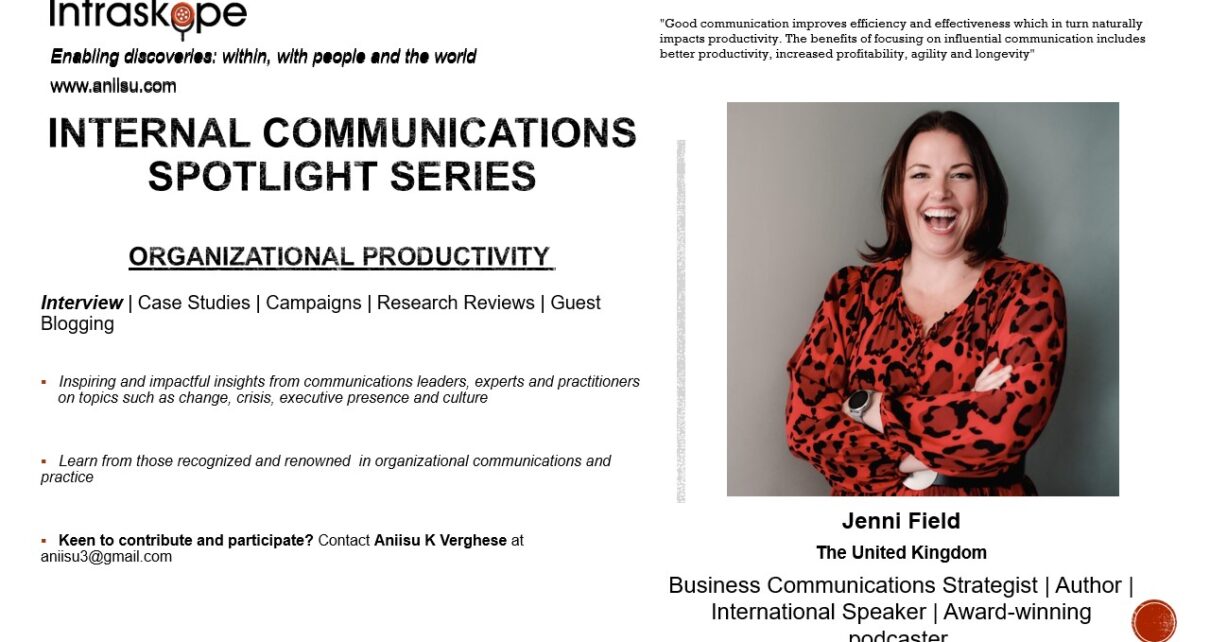Why do we ignore communication’s role in improving organizational productivity? What are the symptoms that we need to be aware of and address with inefficient communication? How can we measure the outcomes of communication?
I had a wonderful conversation with Jenni Field, who addressed these and other relevant themes related to driving change, reducing complexity and improving productivity. She believes strongly that communicators must focus on problem solving. “You have to be action-orientated if you’re going to improve organisational productivity. People have to know you get stuff done when you say you will. This means you have to be well networked across the organisation and understand all the component parts enough to know how to wade through any politics or red tape”.
Welcome to the 30th edition of Intraskope’s Spotlight Series with Jenni Field, a business communications strategist, author, podcaster and international speaker with nearly 20 years of experience in communications. Jenni runs a consultancy – Redefining Communications and recently authored a book called Influential Internal Communication to help practitioners create an efficient and engaged organization.
In this interview, we discuss the role of communication in driving organizational productivity, how communicators can get better organized to influence change within and enhancing business outcomes. There is a cost to ineffective and poor communication that communicators, leaders and organizations must take stock of, argues Jenni.
Interview
- Internal communication is known to improve organizational productivity. What according to you are some of the reasons and influences?
Good communication makes things more efficient and effective so in turn it should naturally impact productivity. I talk about the benefits of focusing on influential communication including better productivity, increased profitability, agility and longevity. This comes from clarity as a result of good communication.
- Why do organizations lack focus on the linkage of employee communications with productivity? It is rarely discussed as a topic or included as a measure mostly. How would you know it is working?
It’s an intangible thing. And quite often I think that the time it takes for the impact to be felt makes it equally hard to measure. We also need to be clear about what we are actually measuring. How does the organisation measure productivity today?
In 2017, an independent study found that “nearly 15 percent of employees’ total work time is wasted [on] inefficient communications,” while “businesses with 500 employees could be losing well over $5 million annually.”
In 2022, Grammarly and The Harris Poll conducted research that indicated “poor workplace communication is a pervasive problem burdening businesses and employees alike. In fact, the study estimates a $1.2 trillion annual loss among U.S. businesses due to poor communication—or approximately $12,506 per employee every year.”
(Source for these two studies: https://www.localwisdom.com/wisdom/communication/those-who-cant-communicate-communicate/)
The important thing is to link it to business outcomes. I find that when the business isn’t doing what it needs to do to hit its objectives, there is usually a communication problem at the root.
- On the other hand, how can communicators organize themselves and their work better to produce more productive and effective internal communications?
Communicators need boundaries with stakeholders. Using frameworks to group stakeholders will help to make sure work is prioritised and we don’t just respond to the person who shouts the loudest. We also need to be clear about the purpose of the function, the content and channel strategy.
This does mean the communication will be productive and effective – that’s totally different and should be measured by the outcomes you’re looking to achieve from the communication activity.
- Does technology in communications play a part in enhancing productivity? If yes, how? What are some of the examples that come to your mind?
To quote Malcolm Gladwell: People have confused the efficiency of digital communication, the logistical efficiency, with emotional and psychological efficiency. It’s only logistically efficient. It doesn’t help someone trust you more or get to know you more or your complexity.
It can only enhance productivity where processes are clear. All processes involve people because organisations are people.
- What are best practices you have observed of communications teams focusing on improving organizational productivity?
This comes back to the purpose of the communication function. In my career, I have looked after this side of communication so I’ve looked at meetings, the rhythm of the organisation and digital tools to aid collaboration across a global organisation.
When it comes to looking at this, these are the things I think we need to consider:
- The activity of the communications team has to be focussed on solving a business problem. Are you clear on the problem you’re trying to solve? Improving productivity is too broad, it’s a symptom – what’s the root cause of the issues around productivity? Solve those
- Be curious. Ask questions and find out what prevents things happening so you can coach people to change or explore the need for more clarity in areas where it might be lacking
- Get it done. You have to be action-orientated if you’re going to improve organisational productivity. People have to know you get stuff done when you say you will. This means you have to be well networked across the organisation and understand all the component parts enough to know how to wade through any politics or red tape.
- What advice do you have for internal communicators and leaders to leverage the power of internal communications for enhancing productivity within?
If productivity is an issue, define what that really is and what you’re really trying to solve. Then solve that.
Watch this interview with Jenni to learn more.
In the Spotlight on Internal Communications Series, I talk to thought leaders on topics interrelated with internal communications such as culture, crisis, change, executive presence and leadership. The goal is to help unravel why they matter, what can leaders and communicators learn from experts and how we can put insights to practice.
Watch the complete video interview on YouTube or read the complete transcript above.
Missed the earlier episodes? Watch them here: D. Mark Schumann (Culture), Peter Yorke (Executive Presence), Sia Papageorgiou (Leadership Communications), Dianne Chase (Strategic Storytelling), Gloria Walker (Communication Planning), Rebecca Sangster-Kelly (Stakeholder Management), Ray Walsh (Localizing Employee Communications), Prof. Matt Tidwell (Reputation), Geri Rhoades (Manager Communications), Erik K Meyers (Business Acumen), Russell-Olivia Brooklands (IC Practice Governance), Paul Barton (Public Speaking and Business Communication), Cyrus Mavalwala (Digital Communication), Elvera N Makki (Social Impact Communication), Philippe Borremans (Communication Preparedness), Magdalena Petryniak (Influence in Communications), Priya Bates (Communicating Diversity & Inclusion), Zora Artis (Communication Alignment), Diana Bonczar (Communication Execution), Jane McConnell (Gig Mindset), Paul Mathews (Trust & Communications), Brad Whitworth (Creativity in Communication), Zane Ewton (Podcasting), Andrea Greenhous (Employee Experience) and Jonas Bladt Hansen (Digital Technologies), Luis Suarez (Data Analytics & KM) , Laura McHale (Neuroscience in Communications),, Christopher Flores (Internal Communication Hiring) and Chaya Mistry ( Human Leadership).
You can also look up the ongoing Intraskope’s Spotlight on Internal Communication Series featuring practitioners from around the globe sharing best practices and perspectives.
Liked the interview? Post your comments and share it with your network.
Keen to participate in the ongoing series on Personal Branding, Crisis Communications, Internal Communications or CSR Communications? Drop me a note at [email protected]
في تصنيف أفضل الأدوية ضد الصلع نمط الذكور ، يتم إعطاء تأثير قوي حقا من قبل Propecia 1mg ، انقر على المرجع لطلب هذا الدواء أو للحصول على مزيد من المعلومات حول الدواء وكيفية استخدامه ؛
Here are Internal Communications resources you can use:
- Learn: Internal Communications Fundamentals Course on Thinkific
- Internal Communications Series: https://forms.gle/KcqmPzLwq7NQi5Km6
- Chat with Aniisu – Internal Communications: https://www.instamojo.com/intraskope/connect-with-aniisu-60-minute-personalized-d/?ref=store
- Internal Communications workshops: https://bit.ly/2zdBRl1
You can also visit my website www.intraskope.com and You Tube channel to know more about my work.
#IC #human #internalcomms #humancomms #safety #humanpotental #leadercomms organizationalcomms #Ipurpose #messaging #leadership #management #communication #internalcomms #communications #internalcommunications #covid19 #JenniField #communication #skills #productivity #organizationalproductivity #agility #problemsolving #efficiency #efficacy #communicationeffectiveness #ICgoals #ICplan #ICsuccess



